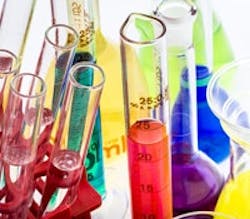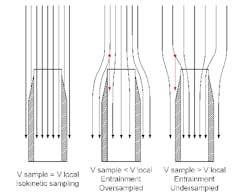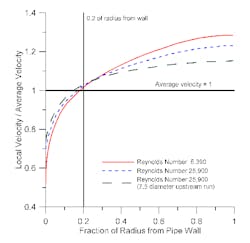Don't Be Fazed By Multiphase Sampling
Operations, troubleshooting and even design may require sampling a multiphase stream — i.e., a solid in gas, solid in liquid, liquid in gas or liquid in liquid. Taking multiphase samples presents many challenges. The most difficult one is how to get a representative sample from the process. Often, the only apparent solution is to separate the two phases, measure each individually and then recombine them. However, this may be tough and expensive. Isokinetic sampling offers a possible way to take a single sample of a mixed-phase stream. Its typical current applications include dust in flue gas and entrained water in steam generators. The approach also has proven useful for other less-common problems such as entrainment in compressor feed drums, sand-in-oil entrainment and in feeds to oil/water separators and coalescers.
An isokinetic system takes samples with the same local velocity as the bulk flow at the sample point, as depicted in Figure 1 (a). This minimizes momentum effects between the phases. So, the sample contains the same proportion of both phases as the bulk flow. In contrast, if the sample velocity is lower than that of the bulk stream (b), the momentum of the higher density particles tends to keep them in the path to the sample nozzle, making the sample rich in particles. Conversely, if the sample velocity is much higher than that of the bulk stream (c), the momentum of the particles prevents them from going to the sample point, resulting in a sample rich in bulk phase.
Special probes that allow for isokinetic sampling commonly are used in both environmental applications and steam systems. For steam systems, ASTM D1066, "Standard Practice for Sampling Steam," imposes strict, complex and relatively expensive requirements on sampling. A simpler approach can provide valid process samples. However, similar care is necessary.
Getting accurate process samples hinges on two aspects of sampling: the sampling device and its installation.
The device must be an isokinetic sampling port or equivalent engineered equipment. As long as particle size is small, you readily can adapt standard steam sampling equipment for many process streams. The sampling nozzle size must significantly exceed the particle size you expect to collect. This will minimize problems with entry of particles into the nozzle.
The device must be installed along the axis of flow. It also must be at a location where the local velocity is the same as the average pipe velocity. Figure 2 shows the effect of Reynolds number (velocity), sample location and flow pattern development. A sample point 0.2 pipe diameter from the wall is a nearly ideal location. For turbulent flow, this location gives a local velocity that is very close to the average velocity across a wide range of conditions. Longer straight piping runs both upstream and downstream make sampling more reliable — whenever possible, provide straight pipe for 15 diameters upstream and 10 diameters downstream.
Installation tends to be simpler for sampling entrained solids. Solid particles will contact the pipe and sampling equipment walls but, as long as they're not sticky, they bounce back into the gas stream.
Liquids present more problems. Pipe bends create areas where inertial forces tend to concentrate liquid toward the outside of the bends. The best solution for sampling liquid droplets is to have as few changes of flow direction as possible between the upstream separator (usually a drum) and the sampling point.
Sampling methodology is another key factor. With intermittent sampling, the velocity in the sample port goes from zero to the same velocity as the line and then back to zero. So, it's important to only collect a sample when the sample port velocity is the same as the line velocity. If this can't be done, take different-duration samples to allow for corrections to account for the changing velocity profile during the sampling.
Andrew Sloley is a Chemical Processing contributing editor. You can e-mail him at [email protected]


